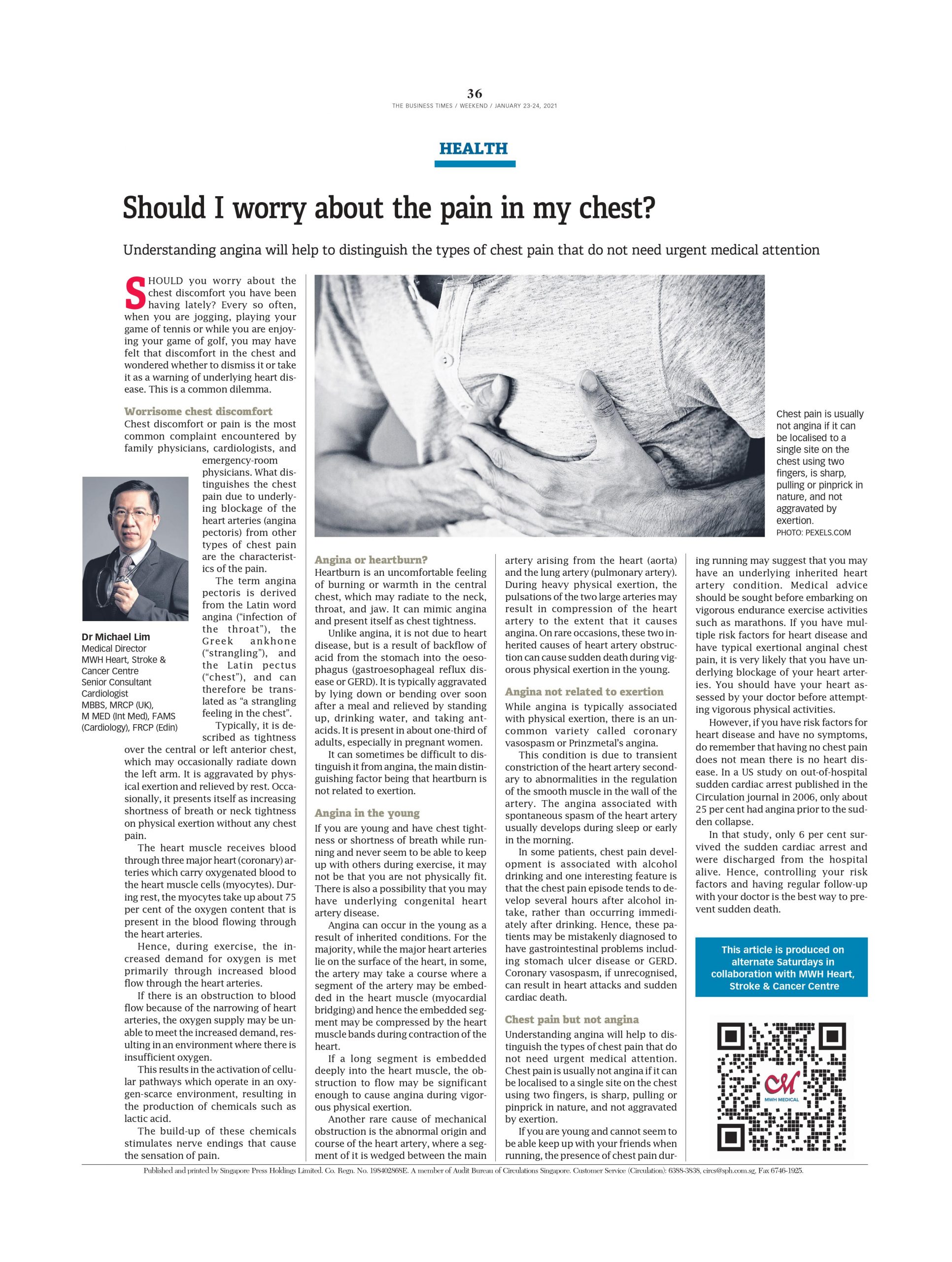Should you worry about the chest discomfort you have been having lately? Every so often, when you are jogging, playing your game of tennis or while you are enjoying your game of golf, you may have felt that discomfort in the chest and wondered whether to dismiss it or take it as a warning of underlying heart disease. This is a common dilemma.
Worrisome chest discomfort
Chest discomfort or pain is the most common complaint encountered by family physicians, cardiologists, and emergency-room physicians. What distinguishes the chest pain due to underlying blockage of the heart arteries (angina pectoris) from other types of chest pain are the characteristics of the pain. The term angina pectoris is derived from the Latin word angina (“infection of the throat”), the Greek ankhone (“strangling”), and the Latin pectus (“chest”), and can therefore be translated as “a strangling feeling in the chest”.
Angina or heartburn?
Heartburn is an uncomfortable feeling of burning or warmth in the central chest, which may radiate to the neck, throat, and jaw. It can mimic angina and present itself as chest tightness. Unlike angina, it is not due to heart disease, but is a result of backflow of acid from the stomach into the oesophagus (gastroesophageal reflux disease or GERD). It is typically aggravated by lying down or bending over soon after a meal and relieved by standing up, drinking water, and taking antacids. It is present in about one-third of adults, especially in pregnant women. It can sometimes be difficult to distinguish it from angina, the main distinguishing factor being that heartburn is not related to exertion.
Angina in the young
If you are young and have chest tightness or shortness of breath while running and never seem to be able to keep up with others during exercise, it may not be that you are not physically fit. There is also a possibility that you may have underlying congenital heart artery disease. Angina can occur in the young as a result of inherited conditions. For the majority, while the major heart arteries lie on the surface of the heart, in some, the artery may take a course where a segment of the artery may be embedded in the heart muscle (myocardial bridging) and hence the embedded segment may be compressed by the heart muscle bands during contraction of the heart.
If a long segment is embedded deeply into the heart muscle, the obstruction to flow may be significant enough to cause angina during vigorous physical exertion. Another rare cause of mechanical obstruction is the abnormal origin and course of the heart artery, where a segment of it is wedged between the main artery arising from the heart (aorta) and the lung artery (pulmonary artery). During heavy physical exertion, the pulsations of the two large arteries may result in compression of the heart artery to the extent that it causes angina. On rare occasions, these two inherited causes of heart artery obstruction can cause sudden death during vigorous physical exertion in the young.
Angina not related to exertion
While angina is typically associated with physical exertion, there is an uncommon variety called coronary vasospasm or Prinzmetal’s angina. This condition is due to transient constriction of the heart artery secondary to abnormalities in the regulation of the smooth muscle in the wall of the artery. The angina associated with spontaneous spasm of the heart artery usually develops during sleep or early in the morning. In some patients, chest pain development is associated with alcohol drinking and one interesting feature is that the chest pain episode tends to develop several hours after alcohol intake, rather than occurring immediately after drinking. Hence, these patients may be mistakenly diagnosed to have gastrointestinal problems including stomach ulcer disease or GERD. Coronary vasospasm, if unrecognised, can result in heart attacks and sudden cardiac death.
Chest pain but not angina
Understanding angina will help to distinguish the types of chest pain that do not need urgent medical attention. Chest pain is usually not angina if it can be localised to a single site on the chest using two fingers, is sharp, pulling or pinprick in nature, and not aggravated by exertion. If you are young and cannot seem to be able keep up with your friends when running, the presence of chest pain during running may suggest that you may have an underlying inherited heart artery condition. Medical advice should be sought before embarking on vigorous endurance exercise activities such as marathons. If you have multiple risk factors for heart disease and have typical exertional anginal chest pain, it is very likely that you have underlying blockage of your heart arteries. You should have your heart assessed by your doctor before attempting vigorous physical activities.
However, if you have risk factors for heart disease and have no symptoms, do remember that having no chest pain does not mean there is no heart disease. In a US study on out-of-hospital sudden cardiac arrest published in the Circulation journal in 2006, only about 25 per cent had angina prior to the sudden collapse. In that study, only 6 per cent survived the sudden cardiac arrest and were discharged from the hospital alive. Hence, controlling your risk factors and having regular follow-up with your doctor is the best way to prevent sudden death.
